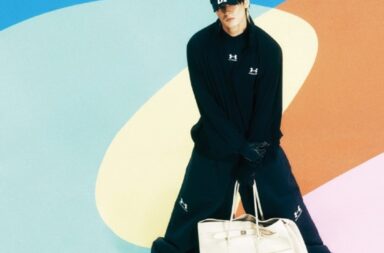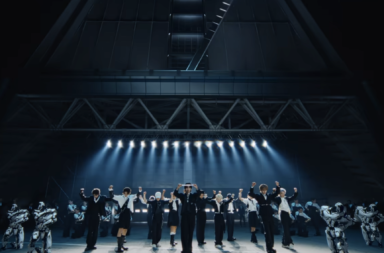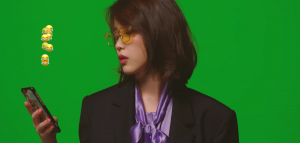 Mid-year review season has arrived, and we’re kicking start our discussions with the MV panel. Brianna, Leesha, and Qing go over their picks, some of which they share in common, but which range over diverse MV types as well.
Mid-year review season has arrived, and we’re kicking start our discussions with the MV panel. Brianna, Leesha, and Qing go over their picks, some of which they share in common, but which range over diverse MV types as well.
| Brianna | Leesha | Qing | |
| 1 | IU – “Palette (feat. G-Dragon)” | B.A.P – “Wake Me Up” | BTS – “Spring Day” |
| 2 | BTS – “Spring Day” | Triple H – “365 Fresh” | Sistar – “Lonely” |
| 3 | Twice – “Signal” | Kriesha Chu – “Trouble” | Seventeen – “Don’t Wanna Cry” |
| 4 | Seventeen – “Don’t Wanna Cry” | Block B – “Yesterday” | Kim Jinho – “Graduation Picture” |
| 5 | Pristin – “Wee Woo” | Mamamoo – “Yes I Am” | KNK – “Sun, Moon, Star” |
Qing: For a moment there, I thought we’d end up with three completely different lists like the last time. Then again, there haven’t been as many outstanding releases so far compared to previous rounds, so I’m not too surprised that we’ve got some picks in common.
Since you guys are new to the MV panel, could you share what you were looking out for in terms of a good MV? What are some of the qualities that make up your criteria?
Leesha: Well I’m a very visual person, so right off the bat anything that’s just a performance version isn’t going to cut it. And also, obviously, I’m a writer so storytelling is a big thing for me too. There are a thousand and one MV tropes that come along in K-pop but a good story will get me every time. I think that’s why B.A.P‘s “Wake Me Up” and Triple H‘s “365 Fresh” were such strong contenders for my top two.
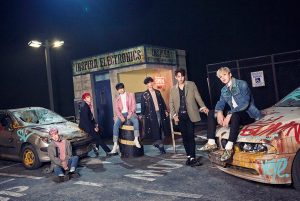 What “Wake Me Up” did was take a personal matter from leader Bang Yongguk and mix it with a rallying war cry that has been the basis for B.A.P since their debut. They group has experimented with different styles, but “Wake Me Up” resonated so much because it felt like home and the story in it felt sincere in a way that a lot of K-pop videos just don’t.
What “Wake Me Up” did was take a personal matter from leader Bang Yongguk and mix it with a rallying war cry that has been the basis for B.A.P since their debut. They group has experimented with different styles, but “Wake Me Up” resonated so much because it felt like home and the story in it felt sincere in a way that a lot of K-pop videos just don’t.
As for “365 Fresh,” I know there was controversy surrounding the rating and the content but that’s kind of what I liked about it. The whole vibe was of watching an old VH1 rock doc. We watched this group on their descent to rock bottom. Maybe missing some elements, but the truth of the matter is that sex and drugs aren’t talked about in K-pop. Not explicitly. There’s the few one liners that make you gasp or may surprise you, but “365 Fresh” was in your face about it. The visuals helped tell the story—everything from the lighting to the wardrobe. It was just really strong storytelling and that’s what won my heart.
Brianna: I would like to say my criteria for a “good” MV isn’t too strict. If it has cohesion and a sense of direction, I’m more inclined to like it. When it came to deciding videos for the MYR, I focused on MVs that were the most memorable to me.
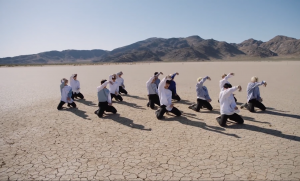
IU‘s “Palette” and Seventeen‘s “Don’t Wanna Cry” were both memorable to me because of the artists’ maturity. “Palette” reflected on IU’s life until now; I’ve only seen IU in passing as a K-pop fan, I could still sense how much she grew up. I’ve been a Seventeen fan for a year now, and “Don’t Wanna Cry” felt like the group’s most mature MV because it was more emotional than others.
BTS‘s “Spring Day” could also pertain to maturity, but I picked it because of its cinematography. I’ve been with BTS since 2013, so I’m confident in saying that “Spring Day” might be one of their most well-produced videos ever. I still get goosebumps thinking about the visuals of the MV. Twice‘s “Signal” and Pristin‘s “Wee Woo” made the list because they were quirky and enjoyable. You know an MV is great when you repeat it several times in one sitting because you liked it so much.
Leesha: I did the review for “Signal” so yeah, I get why you would watch it a few times. As a non-fan I thought it was funny and quirky and it would be an honourable mention for me. My funny and quirky videos went to Kriesha Chu and Block B. “Trouble” was one of the strongest debuts I’ve seen in a while and I was just happy watching the video. It was cheesy but bright and it had style. I liked how innocent it was without being overly sweet but it still told this tale as old as time. “Trouble” and “Yesterday” probably tie as my “trope” MVs but the reasons tropes exist is because they work.
Qing will probably go into “Spring Day” some more, but I’ve been so lost on BTS for a while. Getting caught up in finding the hidden meanings and conspiracy theories turned me off to their videos, though apparently with all the views and great reviews they’ve been getting the direction they’re going in is working for them.
Qing: My criteria hasn’t changed much from what I started out with: the content and meaning of the MV, how well this content is executed—what ideas give form to it, what film techniques are employed—and whether, like Brianna, the MV was memorable. This last factor is anchored in the themes and techniques, but definitely has a personal element as well. The only factor I added was how accessible the MV was, inspired by Gaya’s criteria from our EOY discussion.
One thing that ties my picks together is how intensely and artfully the MVs convey their intended emotions. Because of the immense effort BTS fans dedicate to unravelling the narrative of their MVs, it’s easy to feel overwhelmed and just not bother figuring them out. But for me, it matters less what exactly the “Spring Day” story is about, or how it fits into the larger HYYH narrative. What’s important is how it gave visual form to the song’s message of longing and, above all, hope, with tremendous finesse and sensibility.
We see the boys waiting, travelling, and wandering around alone; although these shots are in colour, they are mostly desaturated or even sepia-toned. The sense of solitude is heightened when contrasted with richly-coloured scenes of the group spending time together. Slow camera tilts contribute to the idea that when alone, the boys are emotionally off-kilter.
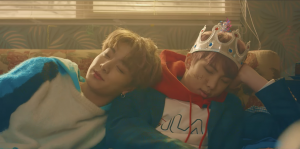 The MV captured small, ordinary gestures that bring out the comfort of companionship, like J-Hope standing next to Suga as they brush their teeth together, Jungkook leaning against the shoulder of a sleeping Rap Monster, and V and Rap Monster sharing a laugh outside the laundromat. This theme of the strength and support friendship brings comes together beautifully when Jungkook races through the different spaces, searching for his hyungs, and his lost expression melts into a relieved smile when they appear next to him.
The MV captured small, ordinary gestures that bring out the comfort of companionship, like J-Hope standing next to Suga as they brush their teeth together, Jungkook leaning against the shoulder of a sleeping Rap Monster, and V and Rap Monster sharing a laugh outside the laundromat. This theme of the strength and support friendship brings comes together beautifully when Jungkook races through the different spaces, searching for his hyungs, and his lost expression melts into a relieved smile when they appear next to him.
It’s one thing to have good ideas and content, but quite another to be able to materialise them the way that BTS’s creative team and Lumpens did. I appreciated the idea behind “Wake Me Up”, and the build up of vignettes depicting the characters’ frustrations and hardships, but the climactic scene in which they are galvanised to break out of their jaded states fell short for me. Leesha, what about the MV worked for you? And Brianna, what landed IU’s “Palette” at the top of your list?
Leesha: “Wake Me Up” struck a nerve personally, but not in the sense of shared suffering as with many who said that the MV resonated with them. The thing that got to me the most was that it wasn’t just a video to go with this song. It wasn’t just about bringing to light body image issues, or talking about mental illness, or any of the other topics the video touches on, though that’s a big thing.
The MV itself was reminiscent of several older B.A.P MV, with shots that throwback to Bang & Zelo‘s “Never Give Up” and even their debut “Warrior”. It was about more than the issues; it felt like everything had come full circle. They’d come from these kids with boundless potential to adults that had to face harsh realities. It was a story within a story if you will, and it made me think more in terms of personal growth than anything else.
Also, the visuals just really stand out. One shot (no pun intended) that always stands out to me is of Himchan with his hands in a prayer position. It’s a small thing, but when looked at in the context of the video, it’s actually quite striking. He’s not actively praying, yet that’s the thought you have. And I know a lot of people, when they’re in trouble, will even pray to a god they don’t believe in to get any help they can.
There’s also some shots with light play, where when the member’s faces are in shadow their eyes are closed, but their eyes are open when the lights are on. It speaks to theme of the video: your issues will keep you in the dark until you wake up and see things for how they truly are. There are small choices that I don’t really have the space to go into that make the bigger picture come together better.
Brianna: As I said before, I’ve only seen IU in passing as a K-pop fan; in other words, I’ve heard a lot about her without actually becoming a fan. After watching “Palette”, however, it felt like I had been with her for the entire journey of her career. I don’t know if it was because I could gather the small nuances and references (such as her “Good Day” dress and the pink cat for her Chat-Shire album), but the MV just made me feel like I had seen it all.
“Palette” landed at the top of my list for a multitude of reasons, but the biggest might be how well it conveyed IU’s journey of maturation. One of the best ways in which this happens is through her outfits. Throughout the MV, she wears about four different ensembles that all seem to convey a certain degree of maturation.
 At her youngest, IU is in her famous pink “Good Day” with long brown hair and a youthful bounce to her steps. She then moves onto pink ombré hair and a blue dress; although it sounds similar through description, she appears young but slightly more mature than before. She then transitions over to short hair and a 20s-style suit; IU’s album Modern Times was said to have a Roaring Twenties feel to it, so perhaps this outfit is indicative of that. Last, but not least, IU has short hair with her final outfit of a dark blazer and pants; this is her now, this is IU in her Palette era.
At her youngest, IU is in her famous pink “Good Day” with long brown hair and a youthful bounce to her steps. She then moves onto pink ombré hair and a blue dress; although it sounds similar through description, she appears young but slightly more mature than before. She then transitions over to short hair and a 20s-style suit; IU’s album Modern Times was said to have a Roaring Twenties feel to it, so perhaps this outfit is indicative of that. Last, but not least, IU has short hair with her final outfit of a dark blazer and pants; this is her now, this is IU in her Palette era.
IU, as both a person and an artist, has grown tremendously over the course of her career. I’ve often seen IU referred to as the “Nation’s Little Sister”; looking at “Palette”, however, it’s evident that she’s no longer little. Matter of fact, she’s transitioned into the older sibling to observe learn from.
Qing: If “Wake Me Up” and “Palette” were reflections on B.A.P’s and IU’s growth and growing pains, “Lonely” marks the bittersweet end of Sistar‘s journey together. It is the most thoughtfully planned goodbye I’ve seen in my time with K-pop, heartfelt and true to their career and all who loved their music. The news of their disbandment, despite casting sorrow over this final comeback, was appropriately timed and crucial to helping us appreciate the release.
Sentiment may have placed “Lonely” a little higher on my list, but the MV doesn’t ride on sentiment alone. It transmutes the sad reality of the disbandment into a stylised representation of loneliness, such that the MV transcends its biographical element. The camerawork transforms the cityscape in which the girls wander into an emotional space. The cross-processing makes it feel like these scenes we are viewing in the narrative present are somehow already past, a melancholic reminder of how with each minute of this comeback, Sistar is slowly becoming history. They are together in so many scenes, but their expressions and the perfectly controlled variation of film speeds reinforces the core feeling of loneliness.
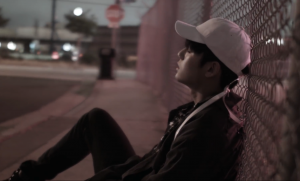 The city is a common backdrop for K-pop MVs, but “Lonely” and “Don’t Wanna Cry” processed the shots in a way that reinforce a sense of solitude that makes it feel almost endemic to the urban landscape. Brianna, “Don’t Wanna Cry” made your list too. What did you appreciate about it?
The city is a common backdrop for K-pop MVs, but “Lonely” and “Don’t Wanna Cry” processed the shots in a way that reinforce a sense of solitude that makes it feel almost endemic to the urban landscape. Brianna, “Don’t Wanna Cry” made your list too. What did you appreciate about it?
Brianna: I mainly appreciated how “Don’t Wanna Cry” brought out Seventeen’s serious side. The song is a lot more emotional than other Seventeen releases, and one can see that in the MV alone.
The colour scheme is muted down to the point that white has the largest presence in the MV, causing it to seem rather monotone. While this might be a downer for some, it works in the case of “Don’t Wanna Cry” by helping to emphasize the solemnity of the song. Rather than have everything be “out there” and all over the place, the compact and light colour scheme really works to the MV’s advantage both in emotion and in overall appearance.
Leesha: Colours matter so much. “Yesterday” got me with the colours. It was so different from Block B’s last MV, but so classically their aesthetic. A lot of the colours are pretty muted, with the brighter ones used to emphasize certain members. Not sure if that was just a bid to fit into a “retro” theme or just a pleasing visual choice from the production team, but either way it was a good idea. It helped ground the MV instead of it being overwhelming like, for instance, “Her”.
On the other hand “Trouble” was super bright—not in colours, just in visuals. It was open and airy and it helped to convey this overall feeling of innocence and lightness that was the vibe of the MV. I think with both MVs, a strength came not just from the colours but from the framing. You obviously expect to be entertained to some degree with any video, but the way that both videos feel inspired by after school specials is fun. Block B went more sitcom versus Kriesha Chu’s more after-school special, yet they manage to feel like a complete show in a little over 3 minutes.
Qing: “Don’t Wanna Cry” got me with its whole package and how its elements came together so well to make a breathtaking dance MV. The choice of open landscapes brings out the expansiveness of the song’s instrumentals, and the crisp cinematography and colours that Brianna mentioned mirrored the clean production and clear vocals. The choreography shots are stunning, and the editing is timed perfectly to the rhythm of the song so that the cuts between the expressive shots and the dance scenes aren’t jarring at all. It’s a MV that’s sculpted just for this song and this artist.
Speaking of colours, Kim Jinho‘s “Graduation Picture” stood out for its simple sepia-dominated colour scheme and old-school textbook illustration style. The narrative is simple to follow, but no less moving. It’s a tribute and a delicately penned letter to a dear childhood friend who has gone through hard times. It’s nostalgic, sweet, funny and gentle, and lets the message of encouragement and comfort shine through.
The colours of KNK‘s “Sun, Moon, Star”, on the contrary, is too low-contrast and foggy for my liking, but it made clever use of simple props to convey longing and sadness. Like a universe that’s missing celestial elements, nothing is quite in proper order in KNK’s emotional world here. Jihun straightens a stray chair, but the whole shot tilts; Heejun‘s helium balloons fall to the ground; glass bottles crash down around Youjin but don’t break. The details are so subtle they are easy to miss, but they are used very effectively.
Leesha: Since Dean‘s “love” (feat. Syd), which was originally on my list, has been blocked and we seemed to have gotten on a color kick, I’m going to talk about Mamamoo‘s “Yes I Am”. If you want something bright and colourful then this is definitely your pick. The MV plays well with the lyrics of the song, where the visuals match up with each member talking about the things that make them special.
For example, Hwasa is the sexy member and she’s lounging a lot in a silk robe and one-piece outfit, along with being dressed up like a secretary (which is a common male fantasy). Her lyrics talk about it becoming summer when she wears a sleeveless top, which alludes to her sexy image. There’s also Moonbyul, who says her style is more suit and tie than dressed up, and she’s styled in a pantsuit which fits her. It’s a super girl power message, but the bright, bold styling brings it more into the summer MV realm, and I like how both those elements blended.
Brianna: I saw “Yes I Am”, so I see where you’re coming from, Leesha. I liked the shots in the video where the members were side-by-side with different backgrounds.
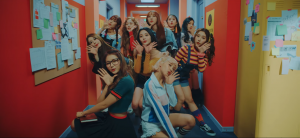 Going off individual styles, one reason I like Pristin‘s “Wee Woo” is its quirkiness and attempt to distinguish members from one another. Xiyeon, for example, is considered the group’s “princess,” and in the MV, she’s sitting in front of a vanity in a pink room with makeup and mannequins. As Qing said before, details like this are subtle but make all the difference.
Going off individual styles, one reason I like Pristin‘s “Wee Woo” is its quirkiness and attempt to distinguish members from one another. Xiyeon, for example, is considered the group’s “princess,” and in the MV, she’s sitting in front of a vanity in a pink room with makeup and mannequins. As Qing said before, details like this are subtle but make all the difference.
As for “Signal”, the faulty superpowers and plot twist made the MV enjoyable. The members getting into dilemmas was entertaining, especially when Nayeon would repeatedly turn back multiple times in one take. Another favourite would be Mina, who ended up hypnotizing herself instead of the crush. There’s a comedic effect involved that also added to the MV’s overall value.
Leesha: With most of summer still left, I think we’re going to get a lot more content, and the EOY review will be very diverse. As it is, I think this half’s releases have hit a wide variety of niches so everyone has a little bit to be happy about. I’m personally looking forward to what the fall will bring.
Readers, which MVs stood out for you in the first half of the year?
(YouTube [1][2][3][4][5][6], Images via Big Hit Entertainment, LOEN Entertainment, Pledis Entertainment, TS Entertainment)
